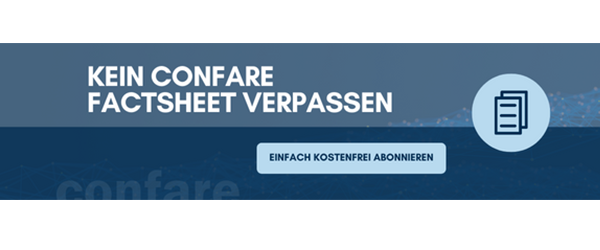OUT now im Confare Blog:
Alexander Laubert, Lakeside: The path from reactive to “Proactive IT” starts with the data
Lakeside
In today’s dynamic market environment, businesses face significant challenges. To meet these, internal IT plays a crucial role. It’s no longer just about fulfilling customer desires and implementing instructions. CIOs must now actively participate in and drive corporate strategy.
Our latest research for the “Proactive IT” factsheet offers exciting insights. We talk with leading IT decision-makers and distinguished CIOs from the Confare network. This factsheet is created in cooperation with Lakeside Software.
In the first part of our big interview with Alexander Laubert, Lakeside’s Director of the DACH-region, Alexander talks about the importance of “Proactive IT”, why few have the right data for it, and what it will take to change that.
Meet the IT management experts from Lakeside at the Confare #CIOSUMMITs in Vienna, Zurich and Frankfurt, the most important CIO gatherings in the German speaking area. Lakeside provides IT executives worldwide with comprehensive insights into their IT systems, infrastructure, and architecture – a crucial basis for truly “Proactive IT”. Register now for free, participation is complimentary for IT managers.
Don’t miss the Confare Factsheet “Proactive IT”. Secure your free subscription to the Confare Factsheet here: Factsheet Subscription.
The second part of our big interview with Alexander Laubert, Lakeside’s Director of the DACH-region, looks at the importance of “Proactive IT” for the productivity and satisfaction of employees in the company and how “Proactive IT” works with the business departments.
Lakeside
What really defines “Proactive IT”? What role do you play as CIO?
Alexander Laubert: A “Proactive IT” strategy allows IT teams to predict and prevent growing issues using endpoint data, root cause analysis, and AI. In contrast to the traditional reactive, break/fix model, “Proactive IT” depends on having complete visibility across the IT estate in order to identify and address key issues, avoiding potential digital disruptions and fire drills; create and leverage automations to resolve issues at scale; and improve the digital  employee experience by deflecting the need for employees to open IT tickets.
employee experience by deflecting the need for employees to open IT tickets.
“Proactive IT” means cutting through the noise to bring real-time IT issues to surface using edge intelligence, analytics, and AI for anomaly detection, proactive alerting, and incident prioritization specific to the IT environment. With a better view of the “dark estate,” IT can see the hidden issues, smartest fixes, and biggest savings.
For CIOs, it is important to align a “Proactive IT” strategy to better digital risk management, cost-savings initiatives, digital transformation goals, digital workplace productivity / employee engagement programs, and efforts to combat the IT talent shortage. “Proactive IT” requires a “shift left” mindset. For organizations that offer tiered IT support, the goal of shifting left is to handle each level of incident on a lower support tier, freeing up highly skilled specialists for other tasks while also enabling end users to address less-complex IT issues on their own.
The ultimate outcome of “Proactive IT” is a better digital employee experience — one that prioritizes employee satisfication and productivity while mitigating business disruption.
Lakeside
Where are the most important areas of action for changing IT from reactive IT to “Proactive IT”?
Alexander Laubert: Start with data. Why? Because data is the key to gaining complete visibility across the IT estate. An ideal IT visibility solution should have multiple levels of insight into the IT environment, including a high-level health score that illustrates the average quality of the end user experience, as well as more granular data on specific devices, applications, networks, and user sentiments.
Data collection at the endpoint can lead to the most accurate and relevant data insights about the digital employee experience and the granular and overall health of the IT estate. Because endpoint data collection happens closest to the end-user experience itself, it provides the most accurate and relevant data for actionable insights related to the individual’s experience with their digital workplace tools. Coupled with sentiment data, endpoint data gives IT teams visibility into issues that not only could be affecting an end user’s ability to do their work but also issues that are affecting their digital experience.
This data is based on the performance of one’s device(s), applications and networks, thereby enabling IT teams to build a complete picture of what’s happening both with the endpoint and across the IT estate. Accordingly, IT teams can detect and curtail issues that potentially may have a direct impact on the employee or end-user experience, or on the successful rollout of an IT transformation project.
Lakeside
How important are sustainability, willingness to innovate and human experience?
Alexander Laubert: Sustainability: As enterprises commit to more sustainable operations as part of their business strategy, it is essential to consider the role that IT plays in achieving these goals. With regulatory requirements such as the Corporate Sustainability Reporting Directive (CSRD), a sustainable IT strategy no longer is nice to have; it is imperative. Given the prevalence of remote and hybrid work environments, enterprises now need a way to account for their vastly dispersed IT assets, including endpoint devices such as employee laptops, hand-held devices across manufacturing and warehousing, point-of-sale devices, and self-serve kiosks.
Achieving sustainability targets requires complete visibility across the IT estate to monitor and measure energy use with the goal of optimizing consumption and extending the asset life cycle — all without affecting the digital employee experience. Sustainable hardware lifecycle management includes promoting a longer lifespan for hardware through regular maintenance and updates.
Lakeside
Willingness to innovation: By nature, most CIOs embrace innovation — from digital transformation initiatives to the integration of generative AI into IT strategy. Innovation must be advanced through the lens of digital risk, however. Any generative AI system or integration will be only as good as the data feeding it. This catch may present the biggest challenge for some innovative enterprises looking to create their own models. Good data is imperative, though, for ensuring the AI model delivers outputs that are relevant, reliable, and explainable. In addition, the AI model should be purpose-built for specific use cases for the business; otherwise, generative AI is just like any other shiny new object that fails to deliver business-centric ROI.
Human experience: Since many CIOs are mapping out generative AI initiatives, it is imperative to develop or integrate incredibly trustworthy models—ones that don’t hallucinate responses that are not explainable. Generative AI models still “hallucinate” (e.g., about 15-20% of the time in the case of the latest ChatGPT model). As McKinsey has noted, “Large language models can be prone to ‘hallucination,’ or answering questions with plausible but untrue assertions. Additionally, the underlying reasoning or sources for a response are not always provided. This means companies should be careful of integrating generative AI without human oversight in applications where errors can cause harm or where explainability is needed.” That’s what is called the “human in the loop.” Human experience is essential. AI without human oversight in applications is dangerous in the wrong hands where the right level of trust has not been established.
Lakeside
What requirements are there for IT infrastructure and IT architecture in order to be able to play the role of “Proactive IT”?
Alexander Laubert: A complete view of digital estate gives IT leaders a better understanding of the interventions and proactive improvements needed to address brewing IT issues before they have an impact on the employee’s digital experience or cause downtime. This visibility is essential for on-premise, cloud, or hybrid environments, and it is even more crucial as employees work remotely on in a hybrid work situation.
Full visibility into the IT environment isn’t always easy to achieve. There are a number of blind spots that organizations have to contend with, such as fragmented data and the complexities of hybrid work environments. The following steps lead to complete visibility of the IT estate:
- Capture data at IT endpoints.
The first step to gaining complete IT visibility is to collect data on how endpoints across the IT environment are performing. Visibility into specific devices is necessary for troubleshooting historical, widespread, and individual user issues such as blue screens, allowing IT staff to perform advanced root cause analysis on unexpected issues, run automated fixes, and otherwise operate the help desk more efficiently.
- Gather insights from endpoint data to pivot to “Proactive IT”.
Data collection is just a starting point. Capturing insights from that data will help build the bigger picture. Knowing what’s happening, how the issue affects the end users, and what can be done to solve any issues that may escalate to other users is critical to the operation of any organization.
Lakeside
Visibility founded on data insights enables IT to better understand the digital employee experience — a process of analyzing usage and performance data across devices to understand the quality of users’ digital experiences. By continuously gathering and analyzing metrics directly from endpoints, IT teams can see the following:
- Hardware and app performance
- Latency time
- CPU, memory, or storage usage
- Network connectivity
- App or system faults
- Slow startup times
These data points can be aggregated and displayed in dashboards and reports that can show at a glance the state of digital environments.
With this level of visibility across the IT estate and into user behaviors, there’s no need to depend on only support tickets filed by end users — if they do so at all — to know what issues are having a negative impact on digital employee experience. IT teams can quickly adopt a proactive approach to IT service delivery, taking preemptive steps that can minimize issues in the first place.
- Maintain a strong IT health score to prevent downtime.
This complete IT visibility sounds great, but digital environments never stay the same for long. As technologies evolve, priorities shift, and the bring-your-own-device (BYOD) culture expands, the IT estate will always change, grow, and become vastly more complex along with it.
This reality makes keeping tabs on everything more difficult, too. And although there are countless tools and solutions out there to help IT departments track bits and pieces of their IT estate, most fall short of providing the breadth and depth of detail needed to see clear across the digital landscape and into end-user experiences in real time.
It’s important to draw on the breadth and depth of data that not only builds a picture but also tells a story. What is that story? A dynamic health score that delivers insights from both real-time data and data captured at the edge for historical context.
Read more: The second part of our big interview with Alexander Laubert, Lakeside’s Director of the DACH-region, looks at the importance of “Proactive IT” for the productivity and satisfaction of employees in the company and how “Proactive IT” works with the business departments.


